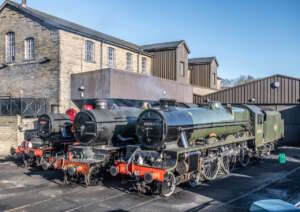To solve problems with trains braking during the autumn leaf-fall season, Northern is testing cutting-edge technology that blasts leaves from the path of its trains.
Significant disruption and delays to services is often caused to services by leaves falling on railway lines.
This is because the leaves stick to damp rails and are compressed by passing trains into a smooth, slippery layer, which reduces the grip of trains’ wheels on the rails.

As a solution to the problem, this autumn Northern has partnered with top engineers and experts to test what rail head treatment technology that is fixed to the undercarriage of passenger trains. If the solution proves practical it could save the rail industry millions of pounds each year.

The technology is called Water-Trak and was developed after it was discovered that leaf-coated rails only become slippery if they are damp, as it was found that trains can still stop safely during heavy rain. Water-Trak works by simply creating conditions that replace those found during rainy-days.
Water-Trak does this by when it detects a slippery rail is, a small amount of water is sprayed from the train onto the surface of the track., which cleans the rail and improves braking conditions for the train.

Leaves on most railway lines are currently cleaned by running special trains called Rail Head Treatment Trains (RHTTs), which between September and December travel regularly over the main parts of the railway network to treat the rails. However, these trains are unable to treat the whole of the British rail network as there are only a limited number of these trains available.
In consequence, these trains are mainly used to treat lines carrying a lot of traffic, such as intercity lines. Inevitably, lines with little traffic such as rural and branch lines often remain untreated. These lines would therefore greatly benefit from the installation of Water-Trak to more trains.
Network Rail’s Performance Innovation Fund is providing funding for the trials, and this autumn five Northern trains have been fitted with Water-Trak and are operating between Liverpool, Wigan, and Manchester, and between Leeds, Harrogate, and York. Leven more trains should have been fitted with the Water-Trak system by next autumn.
Northern first tested the technology in 2021 when two of its Class 319s were fitted with the system and last autumn when 16 of its Class 170s were also fitted.
Rob Cummings, seasonal performance improvement manager at Northern, said: “We’re pleased to be working with Water-Trak to try and provide a better, more reliable service in tricky autumn conditions.
“This is the next stage of this trial that we hope will take us closer to our goal.”
John Cooke, co-founder at Water-Trak, said: “Slippery rails are a massive problem for the rail industry, and we hope to play a big part in resolving this issue.
“We’re hoping that by working with Northern we can make autumn disruption a thing of the past.”






Responses
Nothing new ,steam engines used to have jets of steam onto rails by the wheels and also had sand boxes which dropped sand on rails to aide traction .